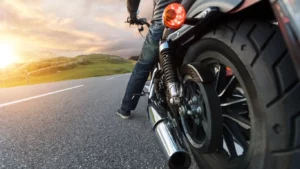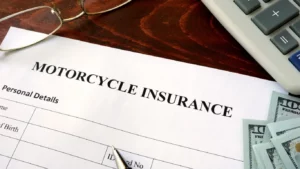The act of a motorcycle rider traveling across lanes or rows of vehicles that are stopped or moving more slowly is referred to as “lane splitting.” This technique is also known as “lane sharing” or “filtering.”
The laws of the state of Washington don’t say much about lane splitting, so it is never allowed.
It is not a legal move, and the Washington State Department of Transportation (WSDOT) tells motorcyclists not to do it because it is illegal and could be dangerous.
As with any other type of vehicle, motorcyclists are permitted to utilize the entire width of a lane; however, they are cautioned to maintain their position within the lane at all times and to avoid passing other vehicles on the right.
Motorcycle riders have a responsibility to guarantee their personal safety as well as the safety of other people who use the road, and one way to do this is to obey all traffic regulations and ride carefully.
What is lane Splitting?
The act of a motorbike rider driving between lanes of stopped or slower moving vehicles, either on the shoulder or in the area between lanes, is known as lane splitting. This technique is also known as lane filtering.
The best time to accomplish this is when there is a lot of traffic and the vehicles are either stopped or moving very slowly.
It is a contentious activity that, in many states of the United States, is not allowed to be done while driving.
While there are those who believe that it is a safe way for motorbikes to navigate through traffic, there are also those who believe that it is risky and puts the lives of other drivers as well as motorcycle riders in peril.
There has only been a limited amount of research done on the subject of lane splitting’s safety, and people have varying perspectives regarding the practice.
In some circumstances, lane splitting has been found to make motorcycle riding safer, while in others, it has been discovered to make it more likely that the rider will be involved in an accident or sustain an injury.
It is essential for those who ride motorcycles to be familiar with the laws and regulations of their state and to adhere to all of the rules of the road while they are out on the road.
If you have any issues regarding lane splitting or the legislation involving motorcycles in your state, you should contact the local authorities in your area or look for additional information on the state’s official website.
Why Lane Splitting Is So Dangerous
There are several reasons why lane splitting can be dangerous for motorcycle riders:
Risk of collision: When a motorcycle “lane splits,” it is travelling between lanes in which other vehicles are either stopped or moving at a slower speed. This raises the possibility of a collision with other cars, and this is especially true if the motorcycle is not visible to other drivers or if the other drivers are not paying attention to their surroundings.
Risk of falling: The rider of a motorbike that is lane splitting has a risk of falling off the bike and onto the roadway if the motorcycle strikes an item or loses its balance. This has the potential to result in severe injuries or even fatalities.
Risk of getting hit from behind: When a motorbike that is lane splitting gets struck from behind by another vehicle, the rider of the motorcycle may be ejected from the motorcycle and onto the road. This can also result in severe injuries or even death in some cases.
Risk of oncoming traffic: It’s possible for two vehicles to collide if one of them swerves into the other’s lane while the other is lane splitting on their motorcycle.
It is essential for people who ride motorcycles to be aware of the dangers involved with lane splitting and to ensure their own safety by adhering to all of the regulations of the road at all times.
If you have any issues regarding lane splitting or the legislation involving motorcycles in your state, you should contact the local authorities in your area or look for additional information on the state’s official website.
lane filtering vs lane splitting
Both lane filtering and lane splitting are names that relate to the practice of a motorcycle rider driving between lanes of stopped or slower moving vehicles, either on the shoulder or in the space between lanes. These maneuvers can be performed either on the shoulder or in the space between lanes.
The best time to accomplish this is when there is a lot of traffic and the vehicles are either stopped or moving very slowly.
There is no meaningful distinction between the two terms “lane filtering” and “lane splitting,” even though they are frequently used interchangeably to refer to the same procedure. This is because there is no practical difference between the two practices.
They both refer to the same behavior, which is a motorcyclist driving between lanes of other cars that are either stopped or moving at a slower speed.
The practice of lane filtering is contentious, and there are numerous places in the United States that do not make it permissible to do so.
While there are those who believe that it is a safe way for motorbikes to navigate through traffic, there are also those who believe that it is risky and puts the lives of other drivers as well as motorcycle riders in peril.
There hasn’t been a lot of research done on the subject of how safe lane filtering is, and people have different perspectives about it.
In certain circumstances, lane filtering has been shown to be safer for motorcyclists, according to the findings of some studies; nevertheless, other research has discovered that it can also increase the chance of collisions and injuries.
It is essential for those who ride motorcycles to be familiar with the laws and regulations of their state and to adhere to all of the rules of the road while they are out on the road.
If you have any issues regarding lane filtering or the legislation involving motorbikes in your state, you should contact the local authorities in your area or look for additional information on the state’s official website.
What Are the Laws That Govern Operating a Motorcycle On a Roadway
Different states have different regulations regarding the use of motorcycles on public roads. In general, however, drivers of motorcycles are expected to abide by the same regulations of the road as drivers of other vehicles. These rules include the following:
- Wearing a helmet: Helmet use while operating a motorbike is policed strictly in various jurisdictions of the United States.
- Obtaining a motorcycle license: Motorcycle riders are often required to hold a motorcycle license or an endorsement on their existing driver’s license in order to legally operate a motorcycle. Typically, this entails demonstrating competency in both written and practical tasks.
- Following traffic laws: The riders of motorcycles are responsible for abiding by all applicable traffic rules, including those pertaining to speed limits, traffic signals, and lane markings.
- Operating in designated lanes: Motorcycles are restricted to a single lane and are not allowed to move between lanes or automobiles in any circumstance (also known as lane splitting or lane filtering).
- Using turn signals:When making turns or switching lanes, motorcyclists are expected to communicate their intentions with turn signals.
- Carrying insurance: In the event of an accident, motorcyclists are normally required to carry insurance coverage for themselves and their bikes.
It is imperative that motorcyclists are well-versed in the laws and regulations of their home state and that they adhere to all of the rules of the road while they are out on the road.
If you have any queries about the regulations that apply to motorbikes in your state, you should get in touch with the authorities in your community or look up the information on the state’s official website to find out more.
What Should I Do If I’m Injured While Lane-Splitting?
If you are injured while lane splitting, it is important to take the following steps:
- Seek medical attention: It is imperative that you get medical assistance as quickly as possible if you have sustained an injury. For medical attention for your wounds, either dial 911 or head to the nearest hospital emergency room.
- Document the accident: Make an effort to snap pictures of the accident scene, including any damage that may have been caused to your motorcycle or any other cars that were involved. Take down the information of any witnesses who saw what happened as well as the information of the other driver, if necessary.
- Contact your insurance company: Immediately after the accident, contact your insurance provider and let them know what happened. They will be able to provide assistance throughout the process of filing claims on your behalf and will also help you obtain the necessary medical treatment.
- Contact a lawyer: If you have sustained serious injuries as a result of the accident, it may be beneficial to get in touch with a personal injury lawyer who can assist you in navigating the legal procedure and safeguard your rights.
It is a contentious activity that, in many states of the United States, is not allowed to be done while driving.
If you have any issues about your rights or the regulations involving lane splitting in your state, you should get in touch with the local authorities in your area or consult a lawyer for further information about the subject.






